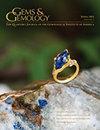Photoluminescence Mapping of Optical Defects in HPHT Synthetic Diamond
IF 1.6
3区 地球科学
Q2 MINERALOGY
引用次数: 3
Abstract
oknown as point defects, absorb visible light to produce color (Collins, 1982). In this way, optical centers give rise to the variety of fancy-color diamonds available in the trade. Optical centers can form as a result of impurities in the diamond (such as nitrogen or boron), deformation of the crystal lattice, missing carbon atoms (vacancies), or a combination of these (Collins, 2003; Breeding and Shigley, 2009). Photoluminescence occurs when an optical center is excited to a higher energy state by the absorption of photons and then returns to its ground energy state, emitting light at a specific wavelength or band of wavelengths (Collins, 1992; Eaton-Magaña and Breeding, 2016). There are currently several hundred known optical centers in diamond that produce photoluminescence (e.g., Collins, 1999; Zaitsev, 2001). Photoluminescence (PL) spectroscopy is a powerful tool used in gemological laboratories to verify whether a specimen is natural or synthetic and determine whether its color origin is natural or due to treatment (Eaton-Magaña and Breeding, 2016). One drawback isHPHT合成金刚石光学缺陷的光致发光映射
也称为点缺陷,吸收可见光产生颜色(Collins,1982)。通过这种方式,光学中心在贸易中产生了各种各样的彩色钻石。由于金刚石中的杂质(如氮或硼)、晶格变形、碳原子(空位)缺失或这些因素的组合,可能会形成光学中心(Collins,2003;Breeding和Shigley,2009)。当光学中心通过光子的吸收被激发到更高的能量状态,然后返回到其基态,发射特定波长或波段的光时,就会发生光致发光(Collins,1992;Eaton Magaña和Breeding,2016)。目前,金刚石中有数百个已知的光学中心产生光致发光(例如,Collins,1999;Zaitsev,2001)。光致发光(PL)光谱法是宝石学实验室中使用的一种强大工具,用于验证标本是天然的还是合成的,并确定其颜色来源是自然的还是经过处理的(Eaton Magaña and Breeding,2016)。一个缺点是
本文章由计算机程序翻译,如有差异,请以英文原文为准。
求助全文
约1分钟内获得全文
求助全文
来源期刊

Gems & Gemology
地学-矿物学
CiteScore
2.90
自引率
19.20%
发文量
10
期刊介绍:
G&G publishes original articles on gem materials and research in gemology and related fields. Manuscript topics include, but are not limited to:
Laboratory or field research;
Comprehensive reviews of important topics in the field;
Synthetics, imitations, and treatments;
Trade issues;
Recent discoveries or developments in gemology and related fields (e.g., new instruments or identification techniques, gem minerals for the collector, and lapidary techniques);
Descriptions of notable gem materials and localities;
Jewelry manufacturing arts, historical jewelry, and museum exhibits.
 求助内容:
求助内容: 应助结果提醒方式:
应助结果提醒方式:


